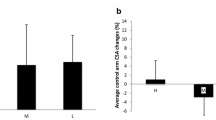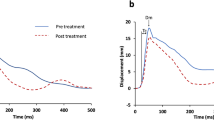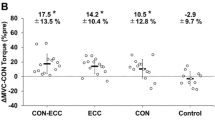Abstract
Five men underwent unilateral resistance training of elbow extensor (triceps brachii) muscles for 16 weeks. Before and after training, muscle layer thickness and fascicle angles of the long head of the triceps muscle were measured in vivo using B-mode ultrasound, and fascicle lengths were estimated. Series anatomical cross-sectional areas (ACSA) of the triceps brachii muscle were measured by magnetic resonance imaging, from which muscle volume (Vm) was determined and physiological cross-sectional area (PCSA) was calculated. Elbow extension strength (isometric; concentric and eccentric at 30, 90 and 180°·s−1) was measured using an isokinetic dynamometer to determine specific tension. Muscle volumes, ACSA, PCSA, muscle layer thickness and fascicle angles increased after training and their relative changes were similar, while muscle and fascicle length did not change. Muscle strength increased at all velocities; however, specific tension decreased after training. Increase in fascicle angles, which would be the result of increasedV m and PCSA, would seem to imply the occurrence of changes in muscle architecture. This might have given a negative effect on the force-generating properties of the muscles.
Similar content being viewed by others
References
Alexander RM, Vernon A (1975) The dimensions of knee and ankle muscles and the forces they exert. J Hum Mov Stud 1:115–123
Amis AA, Dowson D, Wright V (1979) Muscle strengths and musculo-skeletal geometry of the upper limb. Eng Med 8:41–48
An KN, Fui FC, Morrey BF, Linshceid RL, Chao EY (1981) Muscles across the elbow joint: a biomechanical analysis. J Biomech 14:659–669
Antonio H, Gonyea WJ (1993) Progressive stretch overload of skeletal muscle results in hypertrophy before hyperplasia. J Appl Physiol 75:1263–1271
Bo WJ, Meschan I, Krueger WA (1988) Basic atlas of cross-sectional anatomy. Saunders, Philadelphia, pp 283–299
Cutts A (1988) Shrinkage of muscle fibres during the fixation of cadaveric tissue. J Anat 160:75–78
Davies J, Parker DF, Rutherford OM, Jones DA (1988) Changes in strength and cross sectional area of the elbow flexors as a result of isometric strength training. Eur J Appl Physiol 57:667–670
Friedrich JA, Brand RA (1990) Muscle fiber architecture in the human lower limb. J Biomech 23:91–95
Fukunaga T, Roy RR, Schellock FG, Hodgson JA, Day MK, Lee PL, Kwong-Fu H, Edgerton VR (1992) Physiological crosssectional area of human leg muscles based on magnetic resonance imaging. J Orthop Res 10:926–934
Golinick PD, Timson BF, Moore RL, Riedy M (1981) Muscular enlargement and number of fibers in skeletal muscles of rats. J Appl Physiol: Respir Environ Exerc Physiol 50:936–943
Henriksson-Larsen K, Wretling M-L, Lorentzon, Oberg L (1992) Do muscle size and fibre angulation correlate in pennated human muscles? Eur J Appl Physiol 64:68–72
Heslinga JW, Huijing PA (1990) Effects of growth on architecture and functional characteristics of adult rat gastrocnemius muscle. J Morphol 206:119–132
Jones DA, Rutherford OM (1987) Human muscle strength training: the effects of three different regimes and the nature of the resultant changes. J Physiol 391:1–11
Jones DA, Rutherford OM, Parker DF (1989) Physiological changes in skeletal muscle as a result of strength training. Q J Exp Physiol 74:233–256
Kawakami Y, Abe T, Fukunaga T (1993) Muscle-fiber pennation angles are greater in hypertrophied than in normal muscles. J Appl Physiol 74:2740–2744
Kawakami Y, Nakazawa K, Fujimoto T, Nozaki D, Miyashita M, Fukunaga T (1994) Specific tension of elbow flexor and extensor muscles based on magnetic resonance imaging Eur J Appl Physiol 68:39–147
Lieber RL (1992) Skeletal muscle structure and function. Williams and Wilkins, Baltimore, pp 33–46
Maughan RJ, Watson JS, Weir J (1984) Muscle strength and cross-sectional area in man: a comparison of strength-trained and untrained subjects. Br J Sports Med 18:149–157
Maxwell LC, Faulkner JA, Hyatt (1974) Estimation of fibers in guinea pig skeletal muscles. J Appl Physiol 37:259–264
Mikesky AE, Giddings CJ, Matthews W, Gonyea WJ (1991) Changes in muscle fiber size and composition in response to heavy-resistance exercise. Med Sci Sports Exerc 23:1042–1049
Narici MV, Roi GS, Landoni L, Minetti AE, Cerretelli P (1989) Changes in force, cross-sectional area and neural activation during strength training and detraining of the human quadriceps. Eur J Appl Physiol 59:310–319
Powell PL, Roy RR, Kanim PM, Bello A, Edgerton VR (1984) Predictability of skeletal muscle tension from architectural determinations in guinea pig hindlimbs. J Appl Physiol 57:1715–1721
Roman WJ, Fleckenstein J, Stray-Gundersen J, Alway SE, Peshock R, Gonyea WJ (1993) Adaptations in the elbow flexors of elderly males after heavy-resistance training. J Appl Physiol 74:750–754
Rutherford OM, Jones DA (1992) Measurement of fibre pennation using ultrasound in the human quadriceps in vivo. Eur J Appl Physiol 65:433–437
Sale DG, Martin JE, Moroz DE (1992) Hypertrophy without increased isometric strength after weight training. Eur J Appl Physiol 64:51–55
Scott SH, Engstrom CM, Loeb GE (1993) Morphometry of human thigh muscles. Determination of fascicle architecture by magnetic resonance imaging. J Anat 182:249–257
Weiss LW, Clark FC (1987) Ultrasonic measurement of upperarm skeletal muscle thickness. J Sports Med 27:128–133
Wickiewicz TL, Roy RR, Powell PL, Edgerton VR (1983) Muscle architecture of the human lower limb. Clin Orthop Rel Res 179:275–283
Williams P, Goldspink G (1973) The effect of immobilization on the longitudinal growth of striated muscle fibers. J Anat 116:45–55
Zuurbier CJ, Huijing PA (1992) Influence of muscle geometry on shortening speed of fibre, aponeurosis and muscle. J Biomech 25:1017–1026
Author information
Authors and Affiliations
Rights and permissions
About this article
Cite this article
Kawakami, Y., Abe, T., Kuno, SY. et al. Training-induced changes in muscle architecture and specific tension. Eur J Appl Physiol 72, 37–43 (1995). https://doi.org/10.1007/BF00964112
Accepted:
Issue Date:
DOI: https://doi.org/10.1007/BF00964112




